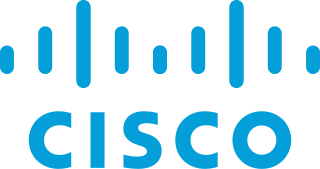H.263 is a video compression standard originally designed as a low-bit-rate compressed format for videoconferencing. It was standardized by the ITU-T Video Coding Experts Group (VCEG) in a project ending in 1995/1996. It is a member of the H.26x family of video coding standards in the domain of the ITU-T.
The Session Initiation Protocol (SIP) is a signaling protocol used for initiating, maintaining, and terminating real-time sessions that include voice, video and messaging applications. SIP is used for signaling and controlling multimedia communication sessions in applications of Internet telephony for voice and video calls, in private IP telephone systems, in instant messaging over Internet Protocol (IP) networks as well as mobile phone calling over LTE (VoLTE).
In multimedia, Motion JPEG is a video compression format in which each video frame or interlaced field of a digital video sequence is compressed separately as a JPEG image. Originally developed for multimedia PC applications, M-JPEG is now used by video-capture devices such as digital cameras, IP cameras, and webcams, as well as by non-linear video editing systems. It is natively supported by the QuickTime Player, the PlayStation console, and web browsers such as Safari, Google Chrome, Mozilla Firefox and Microsoft Edge.
Advanced Audio Coding (AAC) is an audio coding standard for lossy digital audio compression. Designed to be the successor of the MP3 format, AAC generally achieves better sound quality than MP3 at the same bit rate.
Digital storage media command and control (DSM-CC) is a toolkit for developing control channels associated with MPEG-1 and MPEG-2 streams. It is defined in part 6 of the MPEG-2 standard and uses a client/server model connected via an underlying network.
MPEG transport stream is a standard digital container format for transmission and storage of audio, video, and Program and System Information Protocol (PSIP) data. It is used in broadcast systems such as DVB, ATSC and IPTV.
A container or wrapper format is a metafile format whose specification describes how different elements of data and metadata coexist in a computer file.
Timed text refers to the presentation of text media in synchrony with other media, such as audio and video.
IP over DVB or IP over MPEG implies that Internet Protocol datagrams are transferred over the MPEG transport stream, and are distributed using some digital television system, for example DVB-H, DVB-T, DVB-S or DVB-C.
ATSC-M/H is a U.S. standard for mobile digital TV that allows TV broadcasts to be received by mobile devices.
The Real-time Transport Protocol (RTP) specifies a general-purpose data format and network protocol for transmitting digital media streams on Internet Protocol (IP) networks. The details of media encoding, such as signal sampling rate, frame size and timing, are specified in an RTP payload format. The format parameters of the RTP payload are typically communicated between transmission endpoints with the Session Description Protocol (SDP), but other protocols, such as the Extensible Messaging and Presence Protocol (XMPP) may be used.
MPEG-4 Part 20, or MPEG-4 Lightweight Application Scene Representation (LASeR) is a rich media standard dedicated to the mobile, embedded and consumer electronics industries specified by the MPEG standardization group. LASeR is based on SVG Tiny and adds methods for sending dynamic updates and a binary compression format.
ISO base media file format defines a general structure for time-based multimedia files such as video and audio. The identical text is published as ISO/IEC 15444-12.
Wowza Streaming Engine is a unified streaming media server software developed by Wowza Media Systems. The server is used for streaming of live and on-demand video, audio, and rich Internet applications over IP networks to desktop, laptop, and tablet computers, mobile devices, IPTV set-top boxes, internet-connected TV sets, game consoles, and other network-connected devices. The server is a Java application deployable on most operating systems.
IEC 62455 is an International Electrotechnical Commission terminal specification standard, prepared by the IEC 100 Technical Committee (TC), for a service purchase and protection system for digital broadcasts. Its full title is Internet protocol (IP) and transport stream (TS) based service access. This 18Crypt technology aimed to compete the Open Security Framework (OSF) has never been successful in the market where less than 10 000 deployed devices were using it. On the opposite, the OSF aimed as an open approach enabling wider competition has been widely deployed in millions of devices and re-used in many standards like in the USA or in China.
MPEG media transport (MMT), specified as ISO/IEC 23008-1, is a digital container standard developed by Moving Picture Experts Group (MPEG) that supports High Efficiency Video Coding (HEVC) video. MMT was designed to transfer data using the all-Internet Protocol (All-IP) network.
Timed Text Markup Language (TTML), previously referred to as Distribution Format Exchange Profile (DFXP), is an XML-based W3C standard for timed text in online media and was designed to be used for the purpose of authoring, transcoding or exchanging timed text information presently in use primarily for subtitling and captioning functions. TTML2, the second major revision of the language, was finalized on November 8, 2018. It has been adopted widely in the television industry, including by Society of Motion Picture and Television Engineers (SMPTE), European Broadcasting Union (EBU), ATSC, DVB, HbbTV and MPEG CMAF and several profiles and extensions for the language exist nowadays.
SMPTE 2022 is a standard from the Society of Motion Picture and Television Engineers (SMPTE) that describes how to send digital video over an IP network. Video formats supported include MPEG-2 and serial digital interface The standard was introduced in 2007.

